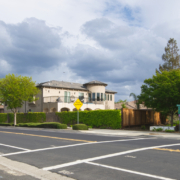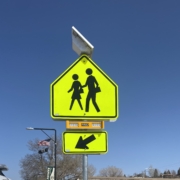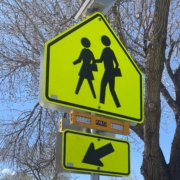Exploring the Impact of Rectangular Rapid Flashing Beacons in Rural and Small Communities
In a world increasingly concerned with road safety, Rectangular Rapid Flashing Beacons (RRFBs) have gained attention as a pivotal technology designed to protect pedestrians, cyclists and other vulnerable road users in uncontrolled marked crosswalks. Much of the existing research on RRFBs has been limited to urban environments, leaving a noticeable gap in our understanding of their effectiveness in rural and smaller communities.
A recent comprehensive study by the University of Vermont in association with the Vermont Agency of Transportation, “Effectiveness of Rectangular Rapid Flashing Beacons (RRFBs) in Small and Rural Communities,” addresses this gap. The study not only affirms the effectiveness of RRFBs in rural settings but also provides key insights for best installation practices. These findings are integral to Availed Technologies’ approach to the design and manufacturing of RRFBs, further reinforcing why Availed is an industry leader.
A Deep Dive into the Study’s Findings
The University of Vermont’s research employed a rigorous methodological approach that included a controlled before-and-after study design and in-depth video analysis. The outcomes were promising: RRFBs led to an improvement in driver compliance and overall road safety in rural Vermont. There were noticeable improvements in driver yielding behavior and reductions in pedestrians crossing outside of designated crosswalks. Pedestrian wait times at crossings also decreased.
Additionally, the study points out that installations in Montpelier, which used different LED lights and are not considered RRFBs, showed less effectiveness compared to other locations. This only strengthens the case for RRFBs as an optimal choice for pedestrian safety solutions.
Furthermore, the study discovered that the effectiveness of RRFBs was consistent, not just in central locations but also in transitional zones between rural and urban areas. This all-encompassing effectiveness is crucial because it shows that RRFBs are not just a ‘one-size-fits-all’ urban solution but a versatile tool for smaller communities and lower pedestrian volume locations.
Design Features and Considerations
This study on RRFBs underscored the importance of thoughtful design features to enhance their effectiveness, especially in adherence to Americans with Disabilities Act (ADA) requirements. Features like tactile arrows and audio cues can help visually impaired individuals navigate crossings safely. Additionally, the study highlighted the need for flexible power options like solar, which is particularly useful in rural areas where electrical grid access may be limited.
The angle and intensity of the flashing lights were also identified as critical design factors. Lights need to be bright enough to attract drivers’ attention from a distance, but not so intense as to impair vision. This balance is especially crucial in varying weather conditions often encountered in rural settings. Moreover, RRFBs should be durable enough to withstand the gamut of environmental conditions, ensuring that maintenance needs are minimized.
Availed Technologies’ focus on advanced design features—including ADA-compliant push buttons, high capacity solar-powered systems, and robust field adjustable RRFB lightbars —makes us an industry leader. These features enable the RRFBs to function optimally in all conditions, ensuring the highest level of road safety for rural communities.
Factors Influencing RRFB Effectiveness
While the study provided an overwhelmingly positive outlook on the role of RRFBs in rural safety, it also illuminated how different factors could affect their effectiveness. These factors include the time of day, the day of the week, and even the type of road users, such as cyclists and runners. Such granular data is invaluable for planners and policymakers who aim to deploy RRFBs most effectively, further underscoring the vital role played by high-quality RRFBs like those manufactured by Availed Technologies.
This is critical because these factors are directly linked to road safety. In particular, the study found that the installation of RRFBs led to improvements in driver compliance ranging from 12% to 43%, showcasing the tangible benefits of these devices. Pedestrian wait times also improved, with reductions ranging from 0.8 to 2.6 seconds at two of the RRFB locations studied.
The Global Relevance of RRFBs
Although the study is rooted in the specific context of Vermont, its findings have broader implications. Rural and small communities across the nation and indeed, around the world, share similar characteristics. The issue of road safety is universal, and the research strongly indicates that RRFBs, when implemented correctly, can be an effective solution for a range of settings.
Making Roads Safer with Availed Technologies’ RRFBs
As the study results indicate, not all RRFBs are created equal. Availed Technologies distinguishes itself by offering RRFBs that not only meet but exceed compliance and safety standards. With our products, communities—be they large or small, urban or rural—can achieve remarkable improvements in pedestrian safety and driver compliance.
Availed’s RRFBs are not just built to meet the basic standards; they exceed them. Our attention to detail ensures maximum visibility and durability, two key factors that are even more crucial in rural settings where regular maintenance may be less frequent. In addition, Availed’s RRFBs are adaptable and can be installed in a variety of roadway conditions, a feature highlighted as beneficial in the study.
As we strive for safer roads for all, there’s no better partner than Availed Technologies to provide RRFB solutions. Grounded in scientific research and committed to quality and safety, Availed’s RRFBs are the best pedestrian safety solution for communities large and small. Your community deserves the best, and the best is Availed Technologies’ AV-400 RRFB.











